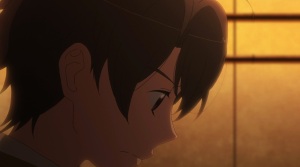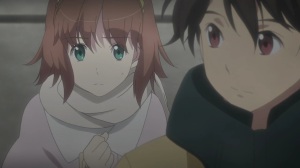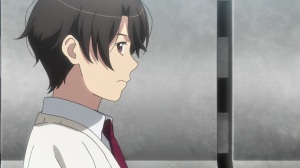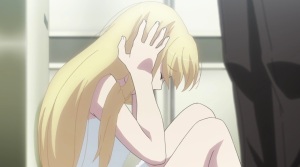Aldnoah Zero’s Kaiduka Inaho: most boring protagonist ever?
December 21, 2014 3 Comments
 |
|
| Key Visual II: Kaiduka Inaho at the start of Aldnoah Zero | |
After choosing to not to post my musings on Inaho at the end of last month, I played with with idea of adding it to my upcoming ’12 days of Christmas’ posts, which I always start on Christmas Day in accordance with real Christian traditions. But it didn’t fit there either, because whilst I did enjoy working out what was going on in his head, there are far too many other things I enjoyed about 2014 in anime. Hence, before I start that series of posts, here is my treatise on one of the things that kept me watching Aldnoah Zero week after week: the character of Kaiduka Inaho.
Needless to say, spoilers ahead…
Inaho: badly written?
I doubt that most viewers in the Western anime sphere would argue with the claim that Inaho got the most flak as the first season was airing. Whilst that could simply be because his detractors were far more vocal and insistent on their point of view than anyone else, one doesn’t have to look very hard to find complaints about how he was basically ‘an emotionless piece of cardboard whose actions were not consistent’, and who was thus badly thought out and/or badly written. But whilst I would agree with those detractors on certain points – for example, it is difficult to empathise with someone who always succeeds with seemingly so little effort or struggle – I completely disagree with all the arguments encompassed in the previous statement. First of all, Inaho wasn’t emotionless: as both viewers and creators have pointed out several times, the issue is that he doesn’t really let his emotions show on his face. Second, Inaho’s actions were consistent and logical if you can figure out what is driving him. And finally, many viewers figured this out just from watching the show, so no, that a number of people really detest him is not an issue with the writing.
 |
 |
| As OnoKen said, “guys say everything with their backs.” | |
Contention #1: Inaho isn’t emotionless, he just doesn’t let his emotions show
The evidence for Inaho not being emotionless, just expressionless, requires pretty close watching of the show. One of the things that detractors kept complaining about was his non-reaction to Okisuke’s death, especially given that he was the one who’d failed to save him. Shouldn’t Inaho be shocked about this? Shouldn’t he be grieving? How cold and unfeeling must he be, to have been able to turn around straight after that and focus on taking down the enemy! The thing is, Inaho was angry and upset about his friend’s death. You can see this in episode 2, in the way he didn’t turn around to answer Calm’s question, and in the serious look on his face at that point. You can also see it in his face and hear it in his voice in when he told Yuki of his friend’s death in episode 3. And above all, there’s that line he says as he put the finishing blows to the Nilokeras, “This is for my friend.” The burning anger I can hear in that one line was what made me start really paying attention to what his seiyuu was doing, and there are a few other points where subtle nuances in his voice work provide more insight into Inaho’s emotions.
 |
 |
| See that sweatdrop on Inaho’s face? He’s worried for Calm and Inko. | |
Another thing I should note is that Inaho’s characterisation requires viewers not to rule anything out even if it hasn’t been shown to us, and also to accept that the creators have chosen certain storytelling techniques over others. Some people continue to complain that the anime should have shown him reflecting on Okisuke’s death afterwards, perhaps running over the scene in his head again and again trying to figure out what else he could have done. However, absence of proof is not proof of absence, and Aoki notes in one interview (Febri #25, October 2014) that they deliberately chose to use as few monologues as possible. This means that viewers have to work harder to figure the characters out. Hence, I’m personally not ruling out the possibility that Inaho does blame himself a little for his friend’s death just because it hasn’t been made clear to us. However, I’d argue that the point to take from what Inaho is shown to do is that he’s probably someone who’d much rather try to make sure it doesn’t happen again, rather than just thinking about something that he cannot do anything about.
 |
 |
| So, hands up anyone who caught this smile in episode 3… | |
Contention #2: Inaho is best understood through his relationships with others
This brings me to the next point: just what is driving Inaho? Simply put, concern for his sister and his friends, and a growing concern for “Seylum-san.” I grant that this isn’t that easy to work out (though it’s true for some of my favourite characters ever written, and not only in ACG!), but when combined with the way he has been shown to focus on the situation at hand and think through it logically, this explains all of Inaho’s actions. In episode 2, the reason he followed the plan he’d made with his sister instead of evacuating himself is because Yuki means a lot to him. You can see their love and concern for each other in everything they do and say: in episode 3, a faint smile flicks across Inaho’s face when he picks up the post-it note that Yuki had left for him – we also find out in episode 11 that he’d kept it! In episodes 5 and 6, the two of them keep trying to argue that the other should not be fighting, though neither goes so far as to overrule the decision that has been made. Frankly speaking, out of all of the relationships in the show, this is the one that I’m most invested in. I’m almost scared to find out how Yuki reacted when she found Inaho after the events of the S1 finale…
 |
 |
| This is my favourite relationship in the entire show. | |
Inaho’s connection with his friends is represented a lot more subtly, and their interactions say a lot about Calm and Inko as well. The way they cooperated against both Trillium and Vlad, especially Calm’s willingness to jump right into the second fight without even asking Inaho what he planned to do, showed just how much they trust each other. The way they react to Inaho’s weirder actions also speaks volumes: they’re used to the weirdly logical way that he sometimes thinks, but they don’t hold it against him at all. The character chart released back in November (Tx/022) clearly shows the contrast between our two protagonists. Inaho is mostly connected to friends, people he has positive relationships with, and his sister. His one negative relationship is with Slaine. On the other hand, Asseylum is the only person that Slaine can call his friend – even though he has started to understand the ‘great cause’ that Saazbaum has told him about, even the count is registered as a negative relationship for him. Perhaps this is one of the reasons Slaine is more popular with fans – after all, why would you want to root for someone who seems to have everything going for him, like Inaho?
 |
|
| The Character Chart from Vs/023 + Tx/023 Orange – family; White = friends; Yellow solid = positive; Yellow dashed = negative |
|
Contention #3: Inaho is changing, largely due to ‘Seylum-san’
Moving on though, let me come to the final reason behind many of Inaho’s decisions in S1. In the series, Inaho actually shows no interest in Asseylum at the start. She’s just a good will ambassador that he’s seen on the news (in contrast, the redevelopment on the outskirts of their town still makes him contemplative, even though he has to have seen it every day on the way to and from school). It’s only later, as he realises that ‘Seylum-san’ is a real, human person, who cares not only for her people but also for the people of Earth and Earth itself, that he becomes drawn to her, and starts putting her near the forefront of his way of thinking about the situations at hand. This starts in episode 3, where he is surprised to find that the foreigner he’d picked up was the apparently assassinated princess, who was now trying to figure out how to end the hostilities her ‘death’ had started. That very evening, he decides to go out to face the second enemy Kat so that she won’t have to put herself at risk again, especially since the risk comes not only from the people trying to assassinate her, but also from any Earthlings who might hold a grudge against the attackers. Similarly, in episode 6, catching a glimpse of her in the well-dock of the ship seems to make him more determined to fight against Hellas, the ‘rocket-punch’ Kat.
 |
 |
| If you watch carefully, you’ll also notice that he pays a lot of attention to the way she reacts to various developments over the course of the show, right from episode 4… | |
Inaho’s growing concern for Asseylum also explains his controversial assertion that Rayet was not an enemy despite Slaine being labelled as one. Going by episode 4, Inaho’s definition of enemy was “someone who is trying to assassinate Seylum-san,” so why did Rayet, who did actually attack Asseylum, escape that label? Well, try considering things from Inaho’s perspective. Given Inaho’s concerns about the princess, the questions he asked of Slaine were completely logical: Inaho wasn’t going to let any unknown person near the princess without being certain that they weren’t an assassin. Some viewers argue that he should have been able to tell from the joy in Slaine’s voice when he realised that he had found Asseylum. However, consider this: what if this unknown Martian was putting up an act in order to get close to the princess, so as to make sure she really dies this time? Whilst I’d agree that Inaho is probably pretty bad at reading people he isn’t close to, I still say that his line of reasoning here was correct. Slaine was labelled an enemy only after he refused to answer the questions and turned his gun on Inaho instead.
As for the oft-mentioned criticism that he should have gotten Slaine to land for an interrogation by his commanding officers, here’s my counterpoint: Inaho was worried about Asseylum, who’d just revealed herself to goodness-knows how many people who might be after her life. He really didn’t have time to worry about the loyalties of a single Martian who refused to answer a simple question. As for the apparent contradiction where he says that Rayet is not his enemy, one factor is that he knows Rayet personally, and could tell that she really had a vendetta against their enemies. However: you can also see him watching Asseylum’s reaction very closely in that shower scene. Hence, I’d argue that one major factor in his decision there was what she needed psychologically at that point. From my perspective, anyone who says that Inaho’s interest in Asseylum came out of nowhere clearly wasn’t watching the same series that the rest of us did.
In conclusion
So that’s Inaho. And this itself serves as proof that it’s not ‘poor writing’ that makes people dislike him; rather, people dislike him simply because they don’t like something about his character. I worked out everything that I’ve written about above by the time episode 12 aired. And based on all the interviews I’ve read since, I’d say that that’s exactly what the creators (Aoki and Takayama) were aiming for. The record of me reaching some of these conclusions can be traced on my twitter (e.g. here or here) and on the AnimeSuki forums (e.g. here). But I maintain that you don’t have to be like Sherlock or Psycho-Pass’s Saito Jouji to work him out, because I am most certainly not that observant. One of the primary ways that Inaho shows his emotions just happens to involve my biggest interest in anime: the voice acting. However, careful attention to visual detail (e.g. that momentary smile in episode 3) and a decent amount of imagination are also required. There are quite a few other viewers besides myself – amongst both Japanese and overseas fans – who managed to catch many of the clues to his character, even if there are points that we all disagree on. However, the two things that seems to connect us all is that Inaho makes sense to us, and we really enjoy figuring him out.
At this point, however, I’m not going to say anything more about the plot. I know the major complaints people have, but all that matters to me is that I’m enjoying Aldnoah Zero, and I’m going to do my best to ensure that other viewers don’t ruin my experience of it. So if that means dropping off the forums once the second cour starts, so be it. I’ll be just fine enjoying it by myself, methinks.
edit (2015-02-24): p.s. I missed this excellent post about people and emotions back when I wrote this. Although I may touch on this topic again when A/Z is finished, I’ll just leave this here now in case I don’t.


i have to say i like inaho compared to so many other mecha protagonists, simply by the fact that he isnt whiny, irritating or angsty but I think that says far more about mecha protagonists in general rather than inaho.
I always thought Inaho was on the spectrum to some degree, that he has difficulty in empathising with those around him, maybe genetic or maybe due to the fact that he was forced to be the “grown-up” at home.
I feel the writing of his character was deliberate simply because the rest of the cast is what would pass off as normal characters in other anime. The anime community in general i feel has trouble accepting things beyond their comfort zone. If he was angsty and unable to relate to others emotion they would not have any problem accepting it but because we was apathetic, I feel it made them uncomfortable unable to place him in their sterotypes of anime characters.
Like you I feel that he had grown as a character through the series. Largely with his interaction with Asseylum-hime. Although I think affection was a part of it and this may just be me thinking too much. But when rewatching I get the feeling that Inaho is lonely, true he has friends but its almost like he’s alone whilst surrounded by people. He truly shines when he pilots and thus he finds meaning in the war and his place in the world. I think he finds Seylum interesting because in a world at war she, the enemy is desperately trying to get people to accept her which is something he has never sought while at peace or at war and in trying to understand her he changes.
Now we dont get too many moments “in Inaho’s head” so obviously nothing i say is backed up but that is my rationalisation for his character.
LikeLike
Well, the creators of A/Z would agree with you: they were deliberately going for characters outside of the two typical types of mecha protagonists (i.e. the whiny, angsty one and the brash, hot-headed one)!!
It’s a bit odd, actually, because Inaho seems to have been a strange kid ever since Heaven’s Fall. It’s covered in the short story about him and Yuki that was included with the 3rd BD/DVD…
Well, I don’t know about that. One of the first characters that came to my mind after I read this part was Guilty Crown’s Shuu, and we know just how beloved he is in the fandom, don’t we? /end sarcasm (^_^;; )
Hm…I don’t really agree with this, possibly because the short story really shows just how out of place he could be. Basically, if Inko hadn’t met Inaho when he and Yuki first moved out on their own, then it’s possible that Inaho would realy be a loner. I think the fact that he and his friends clearly know how each of the others tick, and have so much trust in each others’ abilities, shows that he has found a place in the world. To me, the changes that Asseylum and this war are sparking in him show a different sort of development – though I’ll probably want to see this second cour before I try to elaborate on it. ^^
LikeLike
Pingback: The main problem with Aldnoah.Zero… | HOT CHOCOLATE IN A BOWL